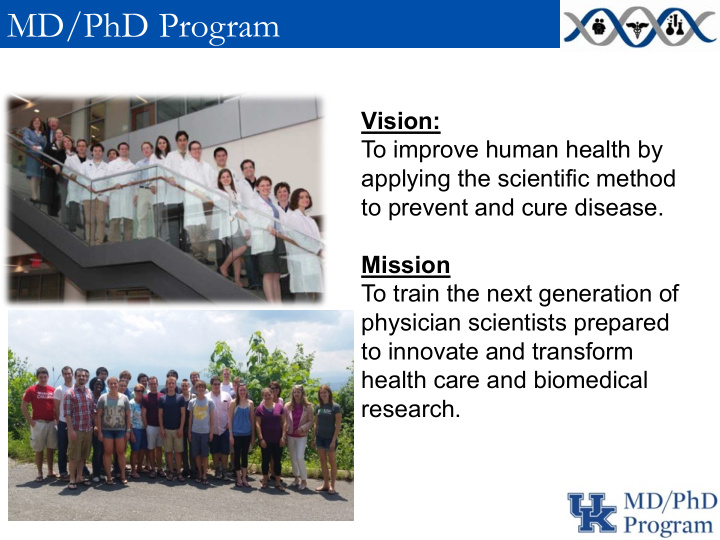



MD/PhD Program Vision: To improve human health by applying the scientific method to prevent and cure disease. Mission To train the next generation of physician scientists prepared to innovate and transform health care and biomedical research.
MD/PhD Program Curriculum The curriculum of the program strives to integrate training in basic biomedical science and clinical investigation Medical Graduate Medical summer MS1 summer MS2 summer Graduate Years MS3 MS4 Research Medical Research Medical USMLE Grad Qual Research Clinical Internship rotation school rotation school Step 1 Courses Exam clerkships Electives courses courses (exempt Research Research Research from AHEC internship) Qual Exam Research Doctoral ICR course Research or ICR course Research Research Clinical submission grad or grad rotation Research courses* courses* * Fundamentals of Clinical Medicine Monthly: Program Meetings, DDLS, CTS seminars Yearly: Student Research Day, Retreat, Welcome Party, Graduation Party
Undergraduate Institutions Arkansas Johns Hopkins Vanderbilt Agnes Scott Miami University-Ohio University of Pennsylvania Boston College Michigan State Yale Washington University Brigham Young University Middlebury College Centre College Pomona College Wabash Davidson Roanoke Wheaton Denison Transylvania Western Kentucky University of Kentucky DePauw UCLA Emory University of Cincinnati University of Texas -Austin Hanover University of Florida University of Georgia Indiana University Cornell University
MD/PhD – Quick Numbers Number of students 30 % women 25% % in-state at matriculation 30% Average GPA 3.8 Average MCAT 34 Application numbers 80 – 120 / year Time to dual degree 7.8 years PhD Programs College of Medicine College of Pharmacy College of Arts/ Sciences - Statistics College of Arts/Science - Sociology Biomedical Engineering
MD/PhD Students 50% publish articles from research done before entering MD/PhD program 80% secure extramural funding for graduate training (NIH, AHA etc.) Pipeline for Center for Clinical and Translational Science Workforce
MD/PhD Publications Average of Aver ge of 6.5 6.5 publicat ations/s /studen ent • Science • Nature • PNAS • Nature Medicine • Nature Structural Biology • Journal of Biological Chemistry • Journal of Virology • J Am Coll Surg • Experimental Neurology • Neurobiology of Aging • J Neuroscience Methods • Trends in Cardiovascular Medicine
MD/PhD Select Honors PAPSCR Conference First Place Poster Award– Erin Wolf Horrell P.E.O. Scholar awards-Erin Wolf Horrell ( educational awards for women who are pursuing a doctoral level degree at an accredited college or university) TERPNET Conference First Place Poster Award – Kristin Linscott NIH F30 Fellowship – Edita Klimyte, Eseosa Ighodaro, Jacqueline Kulbe Robert Terry Neurodegenerative Diseases – Eseosa Ighodaro Halcomb Fellowship in Engineering and Medicine – Scott Thalman Patent/commercial potential –Yuan Wen, “MyoVision:Software for Automated Analysis of Skeletal Muscle Immunohistochemistry”
Student Publications Ben Fowler: Demonstrated that HIV/AIDS drugs that have been used for the last 30 years could be repurposed to treat age-related macular degeneration Established that anti-retroviral nucleosides (nucleoside reverse transcriptase inhibitors; NRTIs)—the class of drugs first developed decades ago to treat HIV— target the innate immune complex known as the NLRP3 inflammasome, a pathway that is involved in AMD pathogenesis Nucleoside reverse transcriptase inhibitors possess intrinsic anti-inflammatory activity. Fowler et al. Science . 2014 346(6212):1000-3
Student Publications Nature Medicine Classic Collection, a series of landmark articles that we had the privilege to publish over the past 15 years that illustrates why Nature Medicine is the “Home of Translational Research.” Cardiovascular Disease Alternatively spliced vascular endothelial growth factor receptor-2 is an essential endogenous inhibitor of lymphatic vessel growth. Romulo J C Albuquerque, et al. Nature Medicine 15 , 1023-1030 (2009) Although endogenous inhibitors of blood vessel growth have been studied extensively, specific inhibitors of lymphatic vessel growth have not been identified. This study reports on the identification of truncated, secreted versions of mouse and human VEGFR-2 receptors generated by alternative splicing. The mouse protein acts as an endogenous inhibitor of lymphatic vessel growth in the cornea and skin, and its administration had therapeutic effects in mouse models of corneal injury and transplantation.
Residency Training Emory - PTSP University of Michigan UCSF Johns Hopkins University of Virginia UCSF Mayo Clinic UT Southwestern UCLA - PTSP Miami – Miller University of Kentucky University of Washington Ohio State University University of Louisville Vanderbilt Georgetown Children's Hospital of Washington University The King's Daughters Indiana University Wake Forest University
Recommend
More recommend